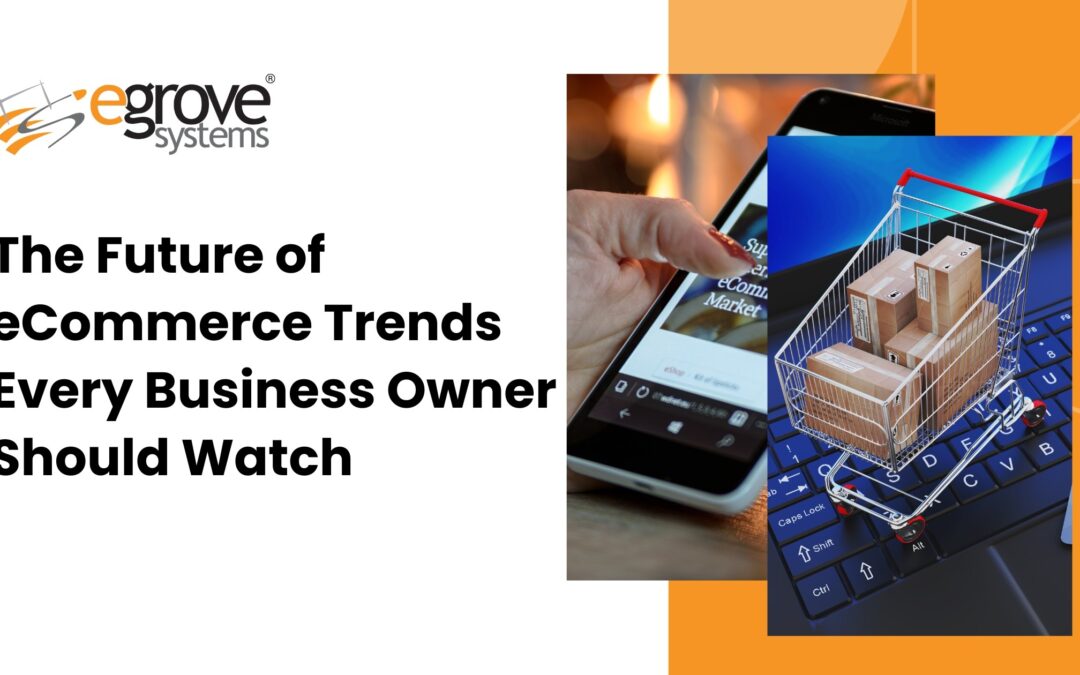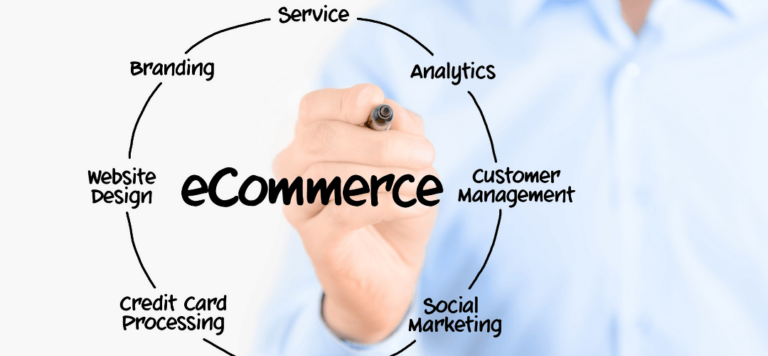Driven by changes in customer behavior, technology developments, and market competitiveness, the eCommerce scene is changing fast. Maintaining your business’s competitiveness, scalability, and profitability depends on you, an eCommerce store owner, keeping ahead of these developments. Every company owner should be ready for the intriguing prospects and difficulties the growing digital industry offers.
This blog will discuss the most important trends influencing the direction of eCommerce and their effects on sectors such as eCommerce development services, eCommerce web development solutions, eCommerce website development services, and specialized markets, including the eCommerce website for groceries.
1. Omnichannel Experiences: Their Emergence
The days of running a single online business as your main source of income are short. Consumers anticipate a flawless buying experience across many platforms, devices, and touchpoints as eCommerce moves towards a completely omnichannel experience.
Combining online storefronts, physical locations, smartphone applications, social commerce, and outside markets like Amazon and eBay, omnichannel retail customers want companies that provide flexibility—that lets them search on one platform, buy on another, and get customer care via yet another channel.
Companies should prepare themselves for this transition:
Integrate systems and data: Invest in eCommerce web development solutions that can unify all consumer data, regardless of where they engage with your business. This guarantees a flawless client experience and makes marketing personalization easier.
Mobile commerce is expanding quickly; hence, your eCommerce website has to be mobile-friendly. Customer retention and conversion depend critically on flawless navigation, quick load times, and basic checkouts on mobile devices.
Use social commerce: Shopping tools included in Instagram, Facebook, and TikTok let users buy straight from social networking applications. Businesses can use social commerce to engage younger, digital-native audiences.
Businesses with a grocery eCommerce website, for example, may benefit from an omnichannel strategy by offering services such as online order placement with in-store pickup, app-based loyalty programs, and instant chat customer care across platforms.
2. Personalized buying based on machine learning and AI
In the eCommerce sector, artificial intelligence (AI) and machine learning (ML) are transforming how companies connect with consumers. Among the most effective uses of artificial intelligence in eCommerce are tailored shopping experiences, where data forecasts consumer behavior, preferences, and purchase intent.
In the future, AI and ML are helping to shape eCommerce as follows:
AI-powered algorithms examine consumer browsing history, historical purchases, and real-time behavior to provide customized product recommendations. These suggestions enhance the buying experience and raise the conversion possibility.
Dynamic pricing—machine learning can instantly change prices depending on consumer behavior, demand, and competition. This allows companies to stay competitive without physically tracking prices and maximizing their pricing policies.
Virtual assistants and chatbots provide instant customer help, answer questions, lead product discovery, and even assist in transaction completion. These instruments improve customer satisfaction and assist in lowering response times.
Including these AI-powered solutions in your eCommerce development program will enable you to provide a more engaging and customized experience, hence increasing client retention and happiness.
3. Sustainability as a Marketing Attractor in eCommerce
In the future, more Companies that use eco-friendly e-commerce methods would help the earth and appeal to customers.
eCommerce companies have numerous methods to include sustainability in their daily activities:
- Eco-friendly packaging—created from recyclable or biodegradable materials—is growing in appeal. This is particularly crucial for industries such as food eCommerce sites, where the regular use of plastic packaging is prevalent.
- More companies are providing carbon-neutral shipping choices or offsetting their carbon emissions via environmental sustainability-focused partnerships.
- Consumers are increasingly looking for businesses that adhere to socially and environmentally conscious sourcing policies.
Adopting these ideas is not just about doing good; it’s also a crucial component of your business identity that could appeal to environmentally minded customers. Being open about your efforts with your eCommerce web development solutions can help foster loyalty and confidence.
4. Voice commerce will shape the future of eCommerce
Voice commerce is the next major eCommerce trend, born out of the emergence of smart home appliances like Amazon Echo and Google Home. Consumers are adopting voice assistants to look for and buy goods as they become more at ease using voice commands for daily chores.
Though it presents special difficulties, voice commerce provides a new horizon for online buying. Business owners should modify their plans to fit this developing trend.
Optimizing your eCommerce website for voice search will be critical, as consumers locate items using voice commands. Changing your SEO approach to concentrate on natural language keywords can help you rank better in voice searches, as voice search inquiries are usually longer and more conversational.
Voice-activated shopping features: Incorporating voice shopping into your eCommerce website-building process will allow you to stay ahead of your competitors. By allowing customers to buy using voice commands, you can provide a quicker and more convenient shopping experience.
5. Consumer Retention Subscription Models
From entertainment (Netflix, Spotify) to meal kits and beauty boxes, subscription services have been rising in appeal in many different fields. The subscription model provides a means for eCommerce to generate consistent income and build client loyalty.
eCommerce offers three primary types of subscription services:
- Customers with replenishment subscriptions get consistent delivery of necessities such as food or home goods. A supermarket eCommerce website may provide weekly or monthly grocery subscriptions tailored to every household’s requirements.
- Consumers get well-chosen items according to their tastes via tailored subscriptions. For sectors like fashion, cosmetics, and food, this approach performs really well.
- Consumers pay a regular cost to access special goods, services, or information. Companies that provide unique, high-value items might use this approach to foster community building and a feeling of exclusiveness around their offers.
While creating lifelong ties with consumers, subscription models provide constant, predictable income. Companies may include subscription management features in eCommerce web development solutions, allowing consumers to easily change, stop, or cancel their subscriptions.
6. Development in Virtual Reality (VR) and Augmented Reality (AR)
Virtual reality (VR) and augmented reality (AR) are not limited to specific sectors or games. They are now significantly influencing eCommerce by improving the online shopping experience; they are now significantly influencing the direction of eCommerce.
For goods like furniture, apparel, and home décor especially, AR and VR technologies, in particular, let consumers see things in a real-world setting before making a buy-through.
Businesses in the eCommerce sector are already utilizing AR and VR technologies in the following ways:
Fashion and cosmetic companies are using AR to enable consumers to digitally test accessories, cosmetics, and clothing. This technique lowers return rates and builds consumer trust in bought goods.
Customers may examine 3D models of items on an eCommerce website, enabling them to view the item from every side. This function improves the online buying process and clarifies the goods for the customers.
AR technologies enable consumers to change items instantly and interactively. Before they click the “buy” button, consumers can see precisely what they are receiving, whether it comes to the color of a new sofa or finishes for a kitchen cabinet.
Including AR and VR in your eCommerce website-building process can differentiate you from rivals and provide consumers with a more dynamic, engaging purchasing experience.
7. Faster, More Versatile Shipping Choices
Shipping speed now plays a critical role in the success of eCommerce companies. Giants like Amazon are driving the expectation for rapid, simple delivery, which is transforming the sector. Growing customer demand for same-day and next-day delivery forces companies to change if they want to remain competitive.
Here’s what e-commerce companies should concentrate on if they want to satisfy these growing expectations:
If you want faster delivery, work with fulfillment facilities that can keep goods close to consumers. This lets you save on delivery costs and timeframes. Investigate local delivery alternatives. Providing local delivery options—especially for time-sensitive goods like groceries—helps your company stand out and satisfy the rising need for convenience. By working with local delivery companies to provide quick, same-day food deliveries, an eCommerce grocery website stands to gain much.
Sustainable delivery solutions: As sustainability becomes more important, consider offering environmentally friendly delivery options in urban areas, such as carbon-neutral shipping or electric vehicle delivery.
Investing in eCommerce web development solutions with integrated modern shipping and logistics capabilities will enable you to provide more flexible and quick delivery choices, therefore keeping your consumers happy.
Finally, although eCommerce presents fascinating possibilities and difficulties going forward, keeping ahead calls for agility and insight. Businesses should set themselves up for success by concentrating on multichannel experiences, customizing the buying process using artificial intelligence, adopting sustainability, and becoming ready for developments like voice commerce and AR.
Investing in eCommerce development services and adapting to emerging technologies such as AR, VR, and AI will ensure your company maintains its competitiveness in a constantly evolving industry. Whether you have a broad online shop or an eCommerce grocery website, these trends are essential for long-term success. As the digital market keeps expanding, your capacity for adaptation and creativity becomes vital.







